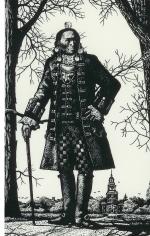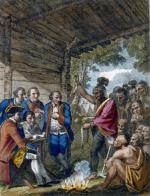![header=[Marker Text] body=[Across the river is the site of the Indian town. "King" Teedyuscung stopped here with Frederick Post, May 17, 1760, on his way to Tioga and the "great concourse in the West."] sign](kora/files/1/10/1-A-225-139-ExplorePAHistory-a0h5d5-a_450.jpg)
Mouse over for marker text
Name:
Wyolutimunk
Region:
Poconos / Endless Mountains
County:
Wyoming
Marker Location:
PA 92, 2.6 miles S of Falls
Behind the Marker
The Delaware chief Teedyuscung exerted a brief but powerful influence on Pennsylvania's Indian affairs during the French and Indian War. At times, he was an eloquent and forceful orator, defending the right of Delaware and other Native Americans who made their homes in the northern Susquehanna Valley. On other occasions, especially when he had had too much to drink, he shifted rapidly between bluster and self-pity, making himself an object of scorn among his native and colonial counterparts. His life story embodies the tragedy of the eastern Delaware who were dispossessed by the Walking Purchase and then forced out of their homes by the
Walking Purchase and then forced out of their homes by the  Connecticut Settlement of the Wyoming Valley.
Connecticut Settlement of the Wyoming Valley.
Teedyuscung was born around 1700 and grew up among the "Jersey" Delaware who lived near modern Trenton, New Jersey. By the time he reached adulthood, the Jersey Delaware were heavily acculturated to colonial society. They wore clothing of European manufacture and used a wide variety of European goods in their everyday lives. Many were converts to Christianity and spoke at least some English. Their social fabric and physical health had also been adversely affected by liquor acquired in the fur trade.
In the early 1730s, Teedyuscung moved with some other Jersey Delaware into the Lehigh Valley of northeastern Pennsylvania, where they joined the "Forks Indians" living in that region. This land, however, was soon sold out from under them in the notorious Walking Purchase of 1737. In the wake of this dispossession, Teedyuscung converted to Christianity and joined the Moravian missionary village of Gnadenhütten on the Lehigh River. He did not enjoy living under his Christian mentors, and in 1754 he moved to the Wyoming Valley in northern Pennsylvania, resettling among other displaced eastern Indians.
Colonial settlers and land speculators were soon grasping at the Wyoming Valley, alienating Teedyuscung and his neighbors at a volatile time on the Pennsylvania frontier. During the French and Indian War, many Wyoming Indians, including Teedyuscung, attacked Pennsylvania communities as retribution for the fraudulent land purchases that had deprived them of their homelands.
At a series of treaty conferences in Philadelphia and Easton between 1756 and 1762, Teedyuscung became the Wyoming Indians' chief spokesman in this regard. Aided by Quakers sympathetic to the Indians' complaints, he delivered speeches attacking the Walking Purchase and similar abuses in Pennsylvania's Indian relations. He faced resistance from the Penn family and the Iroquois Indians of New York, who claimed sovereignty over Indian lands on Pennsylvania's frontier.
chief spokesman in this regard. Aided by Quakers sympathetic to the Indians' complaints, he delivered speeches attacking the Walking Purchase and similar abuses in Pennsylvania's Indian relations. He faced resistance from the Penn family and the Iroquois Indians of New York, who claimed sovereignty over Indian lands on Pennsylvania's frontier.
In his negotiations with the colonists and Iroquois, Teedyuscung sought a permanent recognition from the colonial government of the Delaware Indians' land in the Wyoming Valley. He tried to expand his influence by working as a broker between the colonists and the western Delawares, and in that capacity he accompanied Christian Frederick Post on his trip to Fort Pitt for a peace treaty with the Ohio Indians in 1760.
Christian Frederick Post on his trip to Fort Pitt for a peace treaty with the Ohio Indians in 1760.
But Teedyuscung was also unreliable and volatile in treaty conferences, and his frequent episodes of drunkenness exasperated his colonial allies. Ultimately, he was outmaneuvered by the Iroquois and the Penn family, who cooperated in asserting control over the Wyoming Valley and denying the Delaware title to their lands there.
Teedyuscung was killed in early 1763 in a suspicious house fire that contemporaries believed was the work of colonists, eager to seize the lands he tried to protect. At the same time, the rest of the homes in his small village were destroyed, forcing the survivors to disperse for safety. Shortly after, settlers from Connecticut arrived, claiming the territory as their own.
"This very Ground that is under me (striking it with his Foot) was my Land and Inheritance, and is taken from me by Fraud."
-Teedyuscung to Colonial Officials, 1756
The Delaware chief Teedyuscung exerted a brief but powerful influence on Pennsylvania's Indian affairs during the French and Indian War. At times, he was an eloquent and forceful orator, defending the right of Delaware and other Native Americans who made their homes in the northern Susquehanna Valley. On other occasions, especially when he had had too much to drink, he shifted rapidly between bluster and self-pity, making himself an object of scorn among his native and colonial counterparts. His life story embodies the tragedy of the eastern Delaware who were dispossessed by the
Teedyuscung was born around 1700 and grew up among the "Jersey" Delaware who lived near modern Trenton, New Jersey. By the time he reached adulthood, the Jersey Delaware were heavily acculturated to colonial society. They wore clothing of European manufacture and used a wide variety of European goods in their everyday lives. Many were converts to Christianity and spoke at least some English. Their social fabric and physical health had also been adversely affected by liquor acquired in the fur trade.
In the early 1730s, Teedyuscung moved with some other Jersey Delaware into the Lehigh Valley of northeastern Pennsylvania, where they joined the "Forks Indians" living in that region. This land, however, was soon sold out from under them in the notorious Walking Purchase of 1737. In the wake of this dispossession, Teedyuscung converted to Christianity and joined the Moravian missionary village of Gnadenhütten on the Lehigh River. He did not enjoy living under his Christian mentors, and in 1754 he moved to the Wyoming Valley in northern Pennsylvania, resettling among other displaced eastern Indians.
Colonial settlers and land speculators were soon grasping at the Wyoming Valley, alienating Teedyuscung and his neighbors at a volatile time on the Pennsylvania frontier. During the French and Indian War, many Wyoming Indians, including Teedyuscung, attacked Pennsylvania communities as retribution for the fraudulent land purchases that had deprived them of their homelands.
At a series of treaty conferences in Philadelphia and Easton between 1756 and 1762, Teedyuscung became the Wyoming Indians'
In his negotiations with the colonists and Iroquois, Teedyuscung sought a permanent recognition from the colonial government of the Delaware Indians' land in the Wyoming Valley. He tried to expand his influence by working as a broker between the colonists and the western Delawares, and in that capacity he accompanied
But Teedyuscung was also unreliable and volatile in treaty conferences, and his frequent episodes of drunkenness exasperated his colonial allies. Ultimately, he was outmaneuvered by the Iroquois and the Penn family, who cooperated in asserting control over the Wyoming Valley and denying the Delaware title to their lands there.
Teedyuscung was killed in early 1763 in a suspicious house fire that contemporaries believed was the work of colonists, eager to seize the lands he tried to protect. At the same time, the rest of the homes in his small village were destroyed, forcing the survivors to disperse for safety. Shortly after, settlers from Connecticut arrived, claiming the territory as their own.







